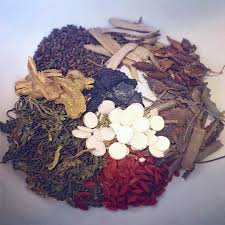
Xiao Yao San, famous or misunderstood?
Source is He ji ju fang
dang gui 9 chai hu 9 bai shao 9 bai zhu 9 fu ling 9 pao jiang 6 bo he 6 zhi gan cao 6
This formula just may be the most famous in the west. It does seem like all our patients are in some form of chronic shao yang pattern. Also, it just may be the most misunderstood formula.
Structure
It is built around the herbs dang gui, chai hu, and bai shao.
Dang gui is the foremost herb for nourishing jue yin liver blood storage. It is pungent, sweet and warm. It increases Wood wind while nourishing Wood. Meaning it is a mild blood moving tonic. It fills the blood vessels and frees blood circulation by nourishing blood. Chai hu allows dang gui to move freely and bai shao controls any excessive movement.
Dang gui and bai shao work together to nourish blood and yin. Bai shao nourishes yin, collects the nutritive qi, while moving the nutritive in blood and opening stagnation. Bai shao buffers convulsions and pain and calms Wood wind. It is the foremost herb for pain due to yin and blood deficiency.
We see the pair dang gui and bai shao in dang gui san and dang gui shao yao san.
In dang gui san chaun xiong is added to create more movement in the jue yin blood layer. Still this movement is considered safe even for pregnant women if used at a low dose.
In dang gui shao yao san the dose of the bai shao is much higher than 10 grams. Chuan xiong is also used at a much higher dose to create more movement in the jue yin blood layer. It is used for all types of abdominal pain, even for pregnant women.
Xiao yao san has a reputation of being the best formula for liver qi stagnation. The use of dang gui and bai shao nourish Wood wind but it only mildly moves the liver blood.
Chai hu is the core shao yang herb. It frees the movement in Wood. Chai hu moves the gall bladder qi while clearing congestion in the form of dampness. It frees the movement of the liver blood which restores the balance of yin and yang in the middle burner. The transformation of Earth relies on the free movement of the element Wood.
Chai hu is not combined with ban xia and huang qin as in xiao chai hu tang. The ban xia transforms phlegm in the stomach and moves the qi downwards. Huang qin dries dampness and cools heat in the stomach and san jiao. Meaning xiao yao san is not as effective as xiao chai hu tang in clearing congestion and heat in the middle burner.
Bai zhu and fu ling drain dampness in Earth to restore control over the Water element. Moving water also moves blood.
Bo he is pungent cool dispersing of heat congestion in the jue yin liver blood. It supports chai hu in clearing congestion heat that can arise from stagnant dampness. It moves Wood and disperses stagnation.
In the source text this formula recommended for blood vacuity taxation fatigue. Dang gui and bai shao nourish blood and yin while chai hu and bo he keep the heat from building up.
Some versions of this formula suggest dried or roasted version of jiang. It seems logical to me to use sheng jiang. This supports tai yin in sending clear qi to to the chest to be dispersed by the lungs and heart to the 100 vessels.
Xiao yao san is limited in clearing the shao yang compared to xiao chai hu tang. It is less nourishing for blood deficiency than dang gui jian zhong tang. Its strength is in transitioning out of a shao yang and into tonifying and nourishing of the tai yin and jue yin levels.
I suggest something like this for getting out of shao yang.
dang gui 9 bai shao 9 chai hu 24 bo he 9 fu ling 9 bai zhu 9 sheng jiang 9 da zao 9 zhi gan cao 6
Modifications
If blood and yin deficiency are causing cramping of the muscles and abdomen use bai shao at 18.
If the blood deficiency is causing stagnant heat to arise add chuan xiong at 9 for move movement. If the heat from the blood deficiency is pronounced add tao ren and mu dan pi to move and cool.
This is a yang formula in that it warms, moves and tonifies the tai yin and jue yin. It is a yin formula in that it nourishes yin and blood and cools heat due to congestion.
We can compare this formula with si ni san which contains chai hu, bai shao, zhi shi and gan cao. In xiao yao san the bai zhu and fu ling replace the zhi shi. Si ni san nourishes blood and yin and drains and dries dampness. It decongests the middle and frees yang to move yin. It is not a real strong shao yang formula and it is limited in supporting tai yin.
It is said of chai hu that it raises yang so we should be careful. Chai hu restores the function of Wood to support Earth. Chai hu only frees the movement of clear food qi so it can rise to the 100 vessels. It does not functionally raise qi but facilitates normal movement.
In the source text this formula is for blood vacuity taxation fatigue. It treats a jue yin blood layer pattern with mild damp accumulation. This treats patterns on a shao yang and jue yin level.
The strength of xiao yao san is as a transitioning formula. It can be used for a mild shao yang pattern and then at a low dose for a long time.